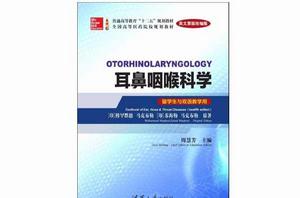內容簡介
本版教材是通過引進著作權改編出版,供臨床醫學留學生和長學制醫學生、研究生、醫學本科生英語或雙語教學使用。本教材對原版書的編寫框架予以保留,將耳科學、鼻科學、咽喉科學、頭頸外科學各部分內容依次順延,按照套用解剖、生理學、症狀學、檢查法、先天性疾病、炎症性疾病、腫瘤、外傷等順序編排。書末附有中英文辭彙對照表臨床常用短語英文 -拼音 -中文對照表。本版教材是清華大學出版社由國外出版社引進著作權,並改編出版,以滿足我國的臨床醫學專業留學生課堂教學和臨床實習需要,供臨床醫學留學生和七年制或八年制醫學生、研究生、醫學本科生英語或雙語教學使用。本教材對原版書的編寫框架予以保留。按照國際一般教材及參考書編寫慣例,將耳科學、鼻科學、咽喉科學、頭頸外科學各部分內容依次順延,按照套用解剖、生理學、症狀學、檢查法、先天性疾病、炎症性疾病、腫瘤、外傷等順序編排,便於學生理解和自學。書末附有中英文辭彙對照表,便於學生學習專業辭彙。本教材的插圖除原始照片外,仍採用彩色,增強視覺效果,便於理解。
前言
1997年天津醫科大學成立國際醫學院,率先創建了留學生全程英文教學,並設有教育部來華留學醫學英語教學師資培訓中心。目前天津醫科大學留學生生源國達到56個,在校留學生1200餘人。天津醫科大學已經自編了《耳鼻咽喉科學》英文教材兩版(1997版,2005版)。所編教材在全國醫學高等院校來華留學生教育教學領域裡具有代表性。
本教材編委是由我國長期從事來華留學生醫學教育的教授、學者,以及長期工作在教學、科研和臨床一線的經驗豐富的耳鼻咽喉科專家組成(包括歸國留學人員)。本教材為來華留學醫學生量身定製,保留地道的醫學專業英語,以簡明、實用、夠用為度,根據教育部培養留學生的教學目標、教學計畫、實踐能力等的要求改編,掌握和熟悉的內容與教學學時一致,少部分提高內容留待自學或拓展用。本教材後附有老師們根據多年醫學留學生教學的經驗自編的英文-拼音-中文對照常見症狀問診要點,方便留學生的臨床實踐套用。
本教材各位編委通力協作,提供大量實例照片。編委所在醫院及科室的同事們提供了極大的支持和幫助。天津醫科大學總醫院耳鼻喉科醫生參與了稿件的整理工作,藉此教材出版之際,我們一併致以深深的謝意。醫學科學診療進展日新月異,臨床醫學教學需不斷創新和知識更新,本教材編寫難免存在紕漏與瑕疵,望各位領導、同道及師生不吝賜教,以便本教材不斷完善。
周慧芳2015年6月29日
目錄
Section1EAR
Introduction……………………………………3
PreliminaryConsiderationsinExamination………………………………3
Chapter1DevelopmentoftheEar…………5
DevelopmentoftheExternalandMiddleEar…………………………………5
DevelopmentoftheInnerEar……………6
DevelopmentoftheBonyLabyrinth……7
Chapter2AnatomyoftheEar………………8
ExternalEar………………………………8
MiddleEarCleft…………………………10
InnerEar……………………………………15
AveragePhysicalDataoftheEar………17
InnerEar……………………………………18
Chapter3PhysiologyoftheEar……………20PhysiologyofHearing……………………20
PhysiologyoftheVestibularSystem……22DistortionintheEar………………………23
Chapter4HistoryTakingwithSymptomatologyofEarDiseases24Deafness……………………………………24
Chapter5ExaminationoftheEar…………27
MethodsofExaminationoftheEar………27
EvaluationofEarDisease…………………29
FunctionalExaminationofEar…………30
RadiologicalExaminationoftheEar……33
ContrastRadiography……………………35
NuclearMagneticResonance……………35
ExaminationoftheVestibularApparatus35
Craniocorpography………………………39
Chapter6CongenitalDiseasesoftheExternalandMiddleEar…………………40
AnomaliesofthePinna……………………40
AnomaliesoftheExternalAuditoryCanal…41
AnomaliesoftheMiddleEar……………41
Chapter7DiseasesoftheExternalEar……43
Perichondritis………………………………43
HematomaoftheAuricle…………………43
FrostbiteofthePinna………………………44
PseudocystPinna…………………………44
OtitisExterna………………………………44
Otomycosis…………………………………45
MalignantOtitisExternal…………………46
KeratosisObturans(CanalWallCholesteatoma)……………………46
ForeignBodiesintheExternalAuditoryCanal…………………………46
ImpactedWaxintheExternalCanal……47
BullousMyringitis…………………………47
TraumaticPerforationsoftheTympanic
Membrane………………………………48
Chapter8DiseasesoftheEustachianTube…49
AcuteEustachianSalpingitis(AcuteTubalCatarrh)…………………49
ChronicEustachianSalpingitis…………49
Chapter9AcuteSuppurativeOtitisMedia
andAcuteMastoiditis……………50
AcuteSuppurativeOtitisMedia…………50
Myringotomy………………………………53
Chapter10ChronicSuppurativeOtitisMedia………………………………56
TubotympanicType(SafeType)…………56
AtticoantralDisease(UnsafeType)………59
TuberculousOtitisMedia…………………60
Chapter11ComplicationsofChronicSuppurativeOtitisMedia………62
Labyrinthitis………………………………62
OtogenicIntracranialInfection…………63
ExtraduralAbscess………………………63
SinusThrombophlebitis…………………64
OtiticHydrocephalus……………………64
OtogenicBrainAbscesses…………………65
Chapter12NonsuppurativeOtitisMediaandOtiticBarotrauma…………67
NonsuppurativeOtitisMedia……………67
AcuteOtiticBarotrauma…………………68
Chapter13AdhesiveOtitisMedia…………70
Etiology……………………………………70
Pathology…………………………………70
ClinicalFeatures……………………………70
Treatment…………………………………70
Tympanosclerosis…………………………71
Chapter14MastoidandMiddleEarSurgery……………………72
IncisionsforExposureofMiddleEarCleft…72
SurgicalProceduresfortheDischargingEar……………………………72
Tympanoplasty……………………………74
Chapter15Otosclerosis………………………77
Etiology……………………………………77
PathologyofOtosclerosis…………………77
TypesofOtosclerosis………………………78
ClinicalFeatures……………………………78
PhysicalFindings…………………………78
DifferentialDiagnosisofOtosclerosis……78
Treatment…………………………………79
Stapedectomy………………………………80
CochlearOtosclerosis……………………81
MalignantOtosclerosis……………………81
Chapter16TumorsoftheEar………………82
TumorsoftheExternalEar………………82
TumorsoftheMiddleEar…………………83
TumorsoftheInnerEar…………………85
Chapter17OtologicalAspectsofFacialParalysis…………………88
FacialParalysis……………………………88
OtologicalAspectsofFacialParalysis…88
Bell’sPalsy…………………………………90
HemifacialSpasm…………………………91ImportantPoints…………………………92
Chapter18Ménière’sDiseaseandOtherCommonDisordersoftheInnerEar…………93
Ménière’sDisease…………………………93Vertigo………………………………………95
VestibularNeuronitis……………………96BenignParoxysmalPositionalVertigo…96
Chapter19Ototoxicity………………………98
Introduction………………………………98
ClinicalFeaturesofOtotoxicity…………99
PreventionandTreatmentofOtotoxicity…99
Chapter20Tinnitus………………………100
TinnitusAurium…………………………100
Chapter21Deafness………………………102
Classification……………………………102
Deaf-Mute………………………………104
AcousticTrauma………………………105
Presbycusis(SenileDeafness)…………106
SuddenDeafness………………………106
PsychogenicDeafness…………………107
Chapter22HearingAidsandCochlearImplant………………………109
HearingAids……………………………109
CochlearImplant…………………………110
Chapter23PrinciplesofAudiometry………116
Acoustics……………………………………116
Audiometry………………………………117
Section2NOSEChapter24DevelopmentandAnatomyofthe
NoseandParanasalSinuses…127
Development……………………………127
Anatomy…………………………………128
ParanasalSinuses………………………130
BloodSupplyoftheNasalCavity……131
NerveSupplyoftheNose……………132
LymphaticDrainageofNoseand
ParanasalSinuses……………………132
Chapter25PhysiologyoftheNoseandParanasalSinuses……………133
Olfactometry(OdorMeasurement)……133
DisturbancesofOlfaction………………134
FunctionsoftheParanasalSinuses……134
MultifariousFunctionsofNose………134
Chapter26CommonSymptomsofNasalandParanasalSinusDiseases……136
NasalDischarge…………………………136
NasalObstruction………………………136
FacialPainandHeadache………………136
Epistaxis…………………………………137
DisordersofOlfaction…………………137
PostnasalDrip…………………………137
SpeechDefect……………………………137
SymptomsduetoExtensionoftheDiseasetotheAdjacentRegions……137
Sneezing…………………………………137
Snoring…………………………………137
SleepApnea……………………………138
Chapter27ExaminationoftheNose,ParanasalSinusesandNasopharynx……139
InspectionandPalpation………………139
AnteriorRhinoscopy……………………139
PosteriorRhinoscopy…………………140
Rhinomanometry………………………141
DigitalPalpationoftheNasopharynx141
Nasopharyngoscopy……………………141
TransilluminationoftheSinuses………142
Sinoscopy………………………………142
RadiologicalExaminationoftheNoseandParanasalSinuses………142
CTScanoftheNose,ParanasalSinusesandNasopharynx…………143
Angiography……………………………143
Chapter28CongenitalDiseasesoftheNose……………………………144
ChoanalAtresia…………………………144
DermoidCystsoftheNose……………145
NasalGlioma……………………………145
Encephalocele……………………………146
Chapter29DiseasesoftheExternalNose…147
FurunculosisoftheNose………………147
CavernousSinusThrombosis…………148
Vestibulitis………………………………148
Erysipelas………………………………148
AcneRosacea……………………………148
LupusErythematosus…………………148
HerpesSimplex…………………………149
HerpesZoster……………………………149
Rhinophyma……………………………149
NeoplasmsoftheExternalNose………149
Chapter30BonyInjuriesoftheFace……151
FractureoftheNasalBones……………151
FracturesoftheMaxilla…………………152
FracturesoftheMalar-ZygomaticComplex………………………………152
Blow-outFractureoftheOrbit…………153
CerebrospinalRhinorrhea……………153
Chapter31ForeignBodiesintheNose…154
InanimateForeignBodies………………154
AnimateForeignBodies………………155
Rhinolith…………………………………155
Chapter32Epistaxis………………………156
AppliedAnatomy………………………156
Examination……………………………158Treatment………………………………158
Chapter33DiseasesoftheNasalSeptum…160
DeviatedNasalSeptum………………160
SubmucousResectionofSeptum……161
Septoplasty………………………………162
Septorhinoplasty………………………163
SeptalHematoma………………………164Septal
Abscess…………………………164
PerforationoftheNasalSeptum………165
Chapter34AcuteRhinitis…………………166
Etiology…………………………………166
Pathology………………………………166
OtherCausesofRhinorrhea……………166
Chapter35ChronicRhinitis………………168
ChronicHypertrophicRhinitis………168
RhinitisCaseosa(NasalCholesteatoma)…168AtrophicRhinitis(Ozena)………………168
TuberculosisoftheNose………………170
SyphilisoftheNose……………………170
Rhinosporidiosis………………………171
Rhinoscleroma…………………………171
MidlineNasalGranulomas……………172
Chapter36NasalAllergy,VasomotorRhinitisandNasalPolyposis…173
NasalAllergy……………………………173
VasomotorRhinitis……………………174
NasalPolyposis…………………………175
Chapter37Rhinosinusitis…………………178
AcuteRhinosinusitis……………………178
ChronicRhinosinusitis…………………180
CystsintheMaxillaryRegion…………190
Chapter38 TumorsoftheNoseand
ParanasalSinuses……………194TumorsoftheNasalCavity……………194
TumorsoftheParanasalSinuses………196Chapter39Headache………………………202
ClassificationofHeadache……………202
Chapter40 FacialNeuralgia(PainintheFace)………………………204
Section3THROAT
Chapter41OralCavityandPharynx……209
AnatomyandPhysiologyofthePharynx…209
SoftPalate…………………………………211
PhysiologyofthePharynx………………211
Deglutition…………………………………211
Chapter42CommonSymptomsofOropharyngealDiseasesandtheMethodofExamination………213
CommonSymptomsofOropharyngeal
Diseases………………………………213
MethodofExaminationoftheOralCavityandPharynx…………………214
Chapter43EvaluationandManagementofthePatientwithaNeckMass…216
AnatomicalConsiderations……………216
BranchialApparatusanditsAbnormalities…………………………216
NeckMasses……………………………220
ManagementofMetastaticCervicalNodes…………………………………220
DiagnosticWork-up……………………221
TumorsoftheParapharyngealSpace…222
SalivaryGlandTumors…………………222
NeurogenicTumors……………………223
OtherNeurogenicTumors……………224
Hemangioma……………………………226
Teratoma…………………………………227
Chapter44Pharyngitis……………………229
AcutePharyngitis………………………229
MembranousPharyngitis………………229
ChronicPharyngitis……………………230
KeratosisPharynges……………………231
SpecificInfectionsofthePharynx……231
StenosisofthePharynx…………………232
Chapter45Tonsillitis………………………233
AcuteTonsillitis…………………………233
ChronicTonsillitis………………………234
AcuteLingualTonsillitis………………235
ChronicLingualTonsillitis……………235
Tonsillectomy……………………………235
PeritonsillarAbscess(Quinsy,ParatonsillarAbscess)………………237
Chapter46Adenoids………………………240
Introduction……………………………240
ClinicalFeatures…………………………240
ComplicationsofAdenoids……………241
Treatment………………………………241
Chapter47PharyngealAbscess…………242
RetropharyngealSpace…………………242
ParapharyngealSpace…………………242
AcuteRetropharyngealAbscess………242
ChronicRetropharyngealAbscess……243
ParapharyngealAbscess………………243
Chapter48TumorsofthePharynx………244
TumorsoftheNasopharynx……………244
NasopharyngealAngiofibroma………244
TumorsoftheOropharynx……………247
TumorsoftheHypopharynx…………248
Plummer-VinsonorPaterson-Brown-KellySyndrome………………………250
Chapter49DevelopmentofLarynxandTracheobronchialTree………251
DevelopmentofLarynxand
TracheobronchialTree………………251
Larynx……………………………………251
TracheobronchialTree…………………255
Chapter50PhysiologyoftheLarynx……256
Phonation………………………………256
Chapter51CommonSymptomsofLaryngealDiseases……………257
ChangesofVoice………………………257
StridorandDyspnea……………………257
WeakCry…………………………………257
Cough……………………………………257
DysphagiaandOdynophagia…………258
Chapter52ExaminationoftheLarynx…259
ExternalPalpation………………………259
IndirectLaryngoscopy…………………259
DirectLaryngoscopy……………………260
Stroboscopy………………………………262
RadiographyoftheLarynx……………262
FiberopticLaryngoscopy………………262
ExaminationoftheLarynxUnderMicroscope(Microlaryngoscopy)…263
Chapter53Stridor…………………………264
Laryngomalacia…………………………265
AcuteLaryngotracheobronchitis………266
AcuteEpiglottitis(AcuteObstructive
SupraglotticLaryngitis)……………266
Diphtheria………………………………267
Chapter54AcuteLaryngitis………………269
PredisposingFactors……………………269
Pathology………………………………269
ClinicalFeatures…………………………269
Treatment………………………………270
AcuteLaryngitisinChildren…………270
Chapter55ChronicLaryngitis……………271
Pathology………………………………271
ClinicalFeatures…………………………271
Reinke’sEdema…………………………271
VocalNodules……………………………271
VocalCordPolyp………………………272
ContactUlcer……………………………273
HyperkeratosisandLeukoplakia……273
AtrophicLaryngitis……………………273
TuberculosisoftheLarynx……………274
LaryngealLupus………………………274
Chapter56LaryngealTrauma……………275
Pathology………………………………275
ClinicalFeatures…………………………275
Treatment………………………………275
LaryngealStenosis………………………275
Chapter57Laryngocele…………………276
Types……………………………………276
Symptoms………………………………276
Chapter58EdemaoftheLarynx…………277
Etiology…………………………………277
AngioneuroticEdema(Quincke’sEdema)…………………………………277
AirwayObstructioninChildrenandAdults…………………………………278
LaryngealSpasms………………………279
Chapter59ForeignBodyintheLarynx
andTracheobronchialTree…280
ForeignBodiesintheLarynx…………280
ForeignBodiesintheTrachea…………280
ForeignBodiesintheBronchus………280
Chapter60LaryngealParalysis…………282
EtiologyofLaryngealParalysis………282
LaryngealParalysisinAssociationwith
otherCranialNerveDysfunction…283
CricoarytenoidJointArthritis…………285
FixedandParalyzedCord……………285
Chapter61Tracheostomy…………………286
AnatomicalRelationsofTrachea………286
Chapter62TumorsoftheLarynx………290
BenignTumorsoftheLarynx…………290
MalignantTumorsoftheLarynx………291
CO2LaserCordectomy…………………294
TotalCordectomy………………………294
Hemilaryngectomy……………………294
ExtendedPartialLaryngectomies……294
OrganPreservationTherapy…………295
AlaryngealCommunication……………295
Phonosurgery……………………………296
Chapter63BlockDissectionoftheNeck…302
RadicalNeckDissection………………302
ModifiedRadicalDissection…………302
SelectiveNeckDissection………………302
ExtendedRadicalNeckDissection……302
Chapter64Bronchoscopy…………………305
Indications………………………………305
ContraindicationsforBronchoscopy…305
Chapter65Esophagus……………………307
SurgicalAnatomy………………………307
InvestigationsforanEsophagealDisease…307
Chapter66Syndromesin
Otorhinolaryngology………309
SyndromeinENT………………………309
Chapter67HeadandNeckCancer
Staging…………………………323
RulesoftheAJCC-UICCSystem………323
FutureofStagingStrengthsofthe
CurrentSystem………………………325
BiologicMarkers………………………325
TheFuture………………………………325
Chapter68CommonENTInstruments…326
English-ChineseWordTranslation…………332
AKey-pointTableofEnglish-PinYin-
ChineseTermsofCommonSymptoms…335

